It’s autumn, and geese are returning from the high north to their wintering areas in the Netherlands. Beautiful, but this year they brought the deadly avian flu with them. During the last few weeks, thousands of wild birds have died in the Netherlands and surrounding countries. Because of outbreaks at six poultry farms in the Netherlands alone, more than half a million chickens and 20,000 ducks have had to be killed. The chances are slim that this is the end of the matter.
We haven’t shaken off Covid-19 yet, but the next deadly virus has already presented itself. The H5N8 bird flu virus came to western Europe from Siberia. The prime suspect is the barnacle goose, which breeds in northern Russia. The virus originally comes from large poultry farms in other parts of Asia, and most likely hitched a ride with waterfowl during their spring migration to arctic breeding areas.
There’s little chance that this strain of avian flu will infect humans, but that doesn’t mean we shouldn’t be worried. History has proven time and again that large pig or chicken farms act as incubators for a deadly virus pandemic.
The chances of this happening are increasing thanks to the growing number of enormous factory farms. In the Netherlands alone, there are now more than 100 million chickens, with often more than 100,000 cooped up together in one barn. These animals aren’t vaccinated against existing strains of bird flu, while this could easily be done.
That’s what one of the worldwide experts on the development of avian flu says: virology professor Thijs Kuiken from the Erasmus University Medical Centre in Rotterdam (whose surname, appropriately, means chick). He specialises in the transmission of viruses from animals to humans. He is busier than ever at the moment, doing research on Covid-19. But he’s also worried about avian flu. Kuiken gave me a crash course on the development of deadly avian flu viruses and what we can do to stop them.
To summarise succinctly: the poultry industry in its current form is a clucking time bomb.
What is avian flu?
Just like the coronavirus, avian flu is a zoonosis. In other words: a disease that can be transferred to humans from other animal species. In itself, this is nothing special: most well-known flu viruses once began as bird flu. The H1N1 avian flu virus, also known as the Spanish flu, killed between 20 and 50 million people 100 years ago when it jumped from animals to humans.
Finger lickin’ good: red junglefowl
Originally, the avian flu virus only occurred in waterfowl such as geese, ducks and swans, in a strain that barely makes them ill, if at all. Wild chickens have never been known to have any kind of bird flu at all. Wild chickens, or Gallus gallus, also known as red junglefowl, live in the forests of Southeast Asia, far from open water.
And open water is what the virus needs to infect birds. Waterfowl can catch the virus up to several weeks later from an infected duck’s droppings in the water. Modelling earlier outbreaks of bird flu shows that the pattern of the spread can only be explained through this kind of indirect transmission. It’s only when water is involved that the reproduction number of the virus, the now familiar R, goes above one.
Because wild waterfowl have been dealing with avian flu for millenia now, they are usually very resistant to it. But now, there’s a deadly strain going around that’s killing them too.
And that’s where poultry farms come in. They are the playgrounds the avian flu virus needs to become deadly.
In order to fully understand this, we have to go back to the start. The birth of a virus.
How bird flu becomes deadly
Viruses cannot reproduce by themselves. They are merely envelopes containing little bits of genetic material. In the case of bird flu, there are always eight loose bits of RNA per virus particle (compare this to human DNA, divided over 46 chromosomes). Cells of other organisms can absorb, replicate and spread viruses.
And during this replication process, two things can happen that lead to a new strain of the avian flu virus.
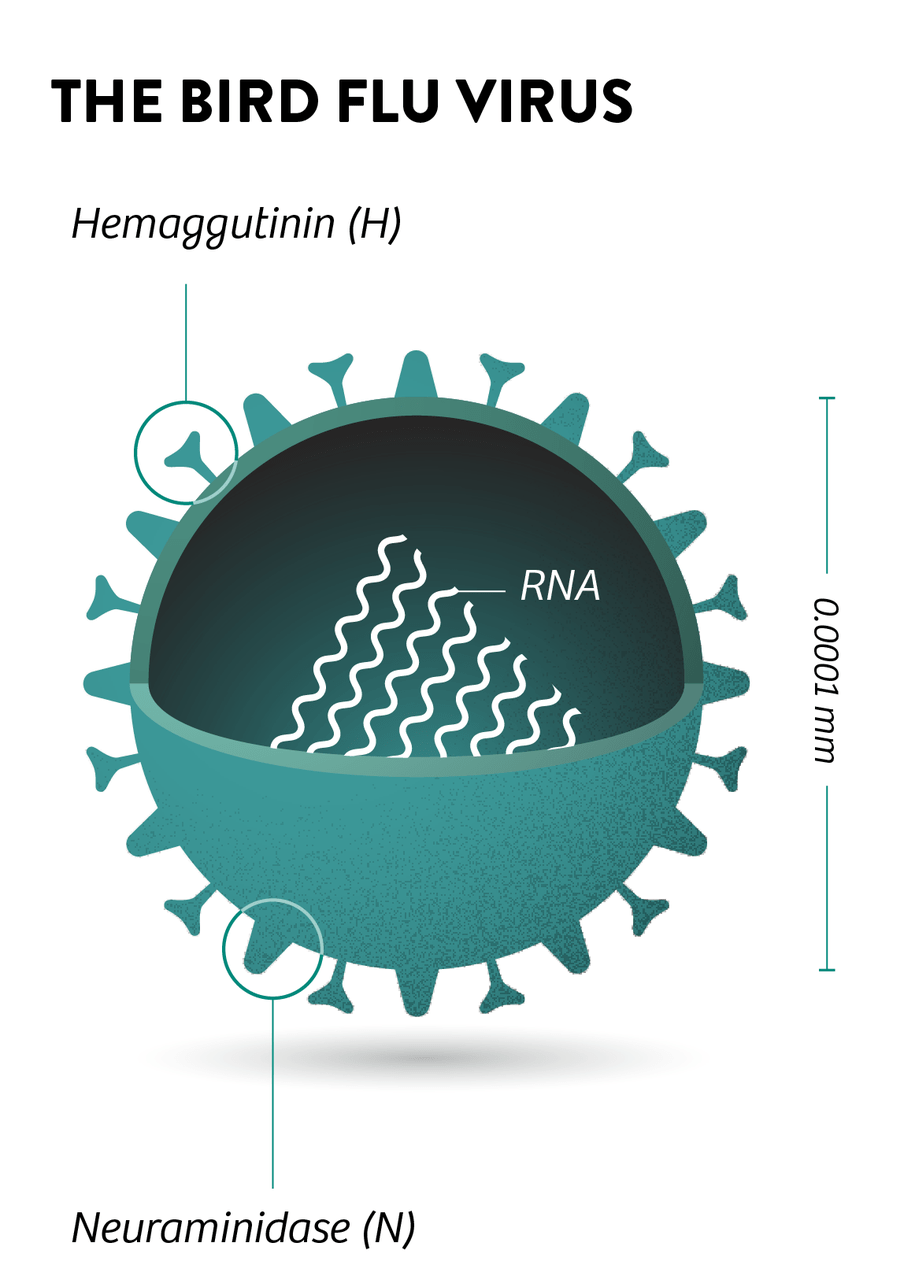
Method 1: Reassortment
One way a new virus can develop is through reassortment. This happens when one or a number of those eight bits of genetic material from two different virus particles are mixed together during the replication process. Usually, this leads to nothing, because just like human cells need all 46 chromosomes, a virus can only grow normally if it has all eight pieces of RNA. But sometimes, after one of these mixups, the daughter virus does have all eight pieces, some from one parent virus and some from the other.
The names of the different strains of the avian flu, such as H5N8, refer to the different subtypes of two proteins, so-called "surface proteins" that protrude from the surface of the virus (hemagglutinin and neuraminidase). If a cell is infected with an H1N1 subtype and an H5N8 subtype of the virus, an H1N8 or H5N1 subtype could develop through reassortment. A new virus is born.
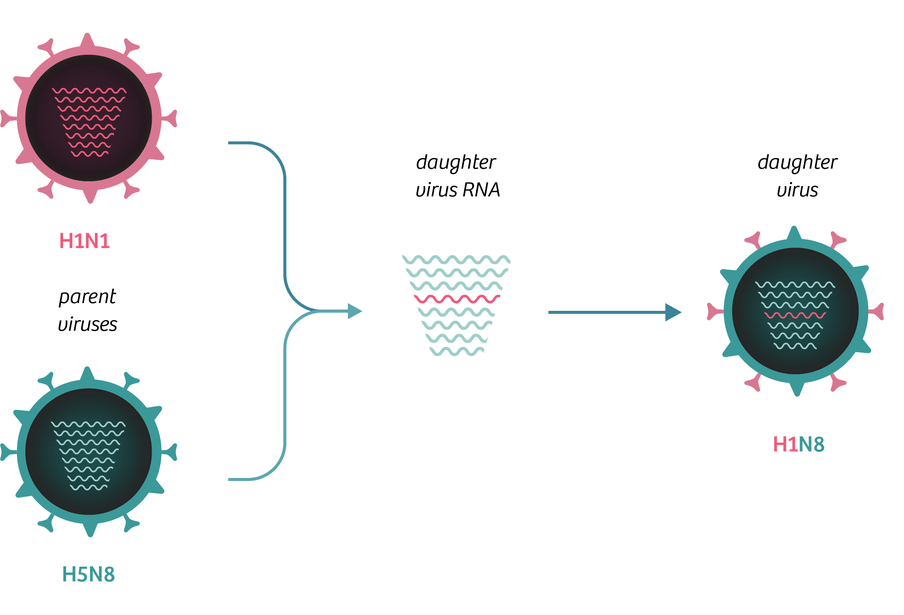
But reassortment isn’t enough to make the virus deadly. And it can’t happen so easily in a chicken, because the animal would have to catch a double bird flu infection – not only in its body, but in the same specific cell in the body. Geese and ducks are much more resistant to bird flu and can carry it for much longer, so the chances are greater for them, although they remain small.
These chances increase when there are large numbers of geese or ducks close together, like at breeding farms. If they also come into contact with wild birds, and thus with more subtypes of the virus, there is a serious possibility that a new virus will develop this way. This is especially the case in Asia, for instance when large groups of domesticated ducks are let loose on rice fields after the harvest in order to eat plant remains and snails.
Method 2: Mutation
The only way a new virus can become deadly is through mutation. This can happen in chickens, because it requires only one virus particle. All it takes is one error in the replication of the genetic material, but it must occur in a crucial spot.
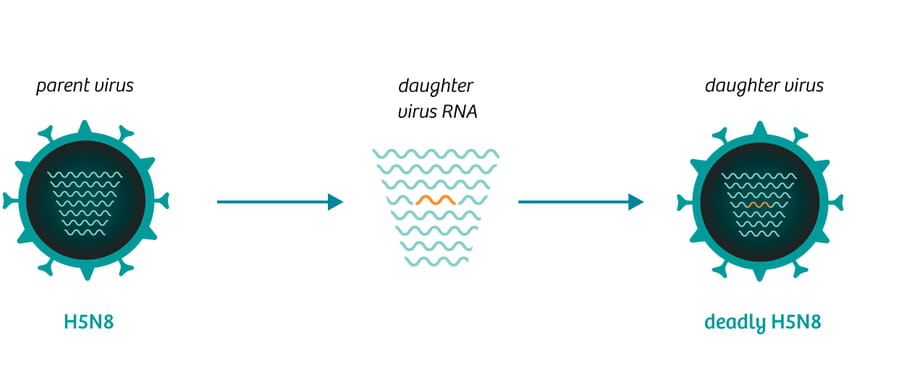
Normally, a bird flu virus can only be absorbed and replicated in specific intestinal and bronchial cells, because this is the only place where an enzyme can be found that is required for making one of the surface proteins (hemagglutinin). Birds do become ill, in that case, but not seriously.
But in the case of a virus with that specific mutation, that surface protein can also be made with another enzyme, one which occurs everywhere in the body. And so the virus can suddenly be absorbed and replicated throughout the entire body. This makes the virus much more harmful, and as a result, birds can become extremely ill and die. In technical jargon: the virus has become “highly pathogenic”.
One of these killer mutations could take place in the wild, even though the chances are much smaller. But in the wild, the deadly symptoms mean that the virus is barely able to spread. The “host” – the animal carrying the virus – is usually already dead before it can infect the next host. Thank God.
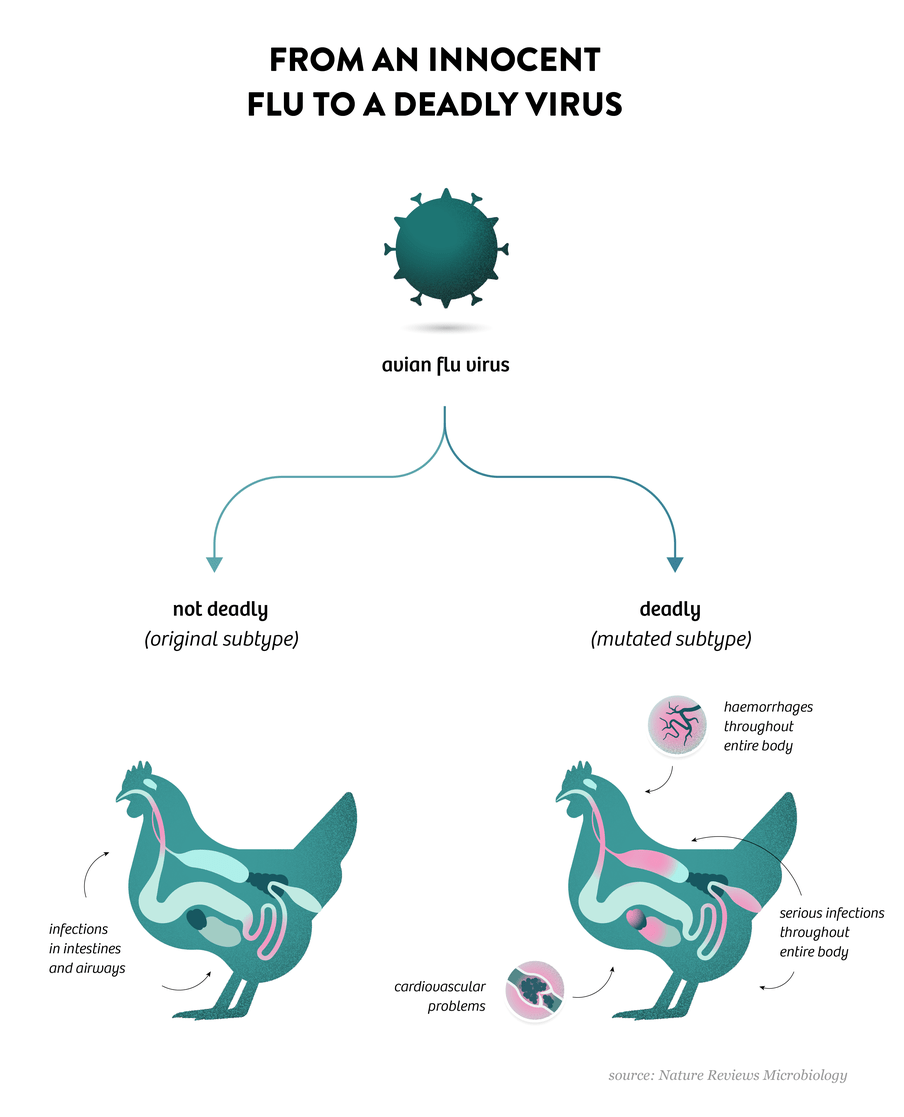
Lots of chickens close together: party time!
That’s where poultry farms come in again. Although bird flu normally only spreads via water, chickens are cooped up so close together in modern poultry farms that the virus can spread there without the aid of water. And when an infected chicken kicks the bucket, other chickens sit on it for a while and are easily infected too. That’s how a killer virus can spread.
And when that happens, it’s party time for the virus.
A mutation that leads to a viable change in the bird flu virus is rare. But when there is such an enormous number of chickens (an average 60,000 per farm in the Netherlands), the virus is replicated billions of times within no time at all. So even though viable mutations are rare, the virus is replicated so often that it is mutating continually.
This means there’s a wave of new variations of the virus developing. Variation is the basis for natural selection. And natural selection works according to a logical principle: those that reproduce fastest will become the most plentiful. For a virus in a heap of chickens, that means strains where a sick chicken infects many other chickens quickly.
This is how a virus can develop that is not only deadly, but also very contagious. For chickens, and sometimes for people, too.
This is the nightmare scenario.
Why these heaps of chickens?
The most important thing to remember from this technical account: because chickens live in such close proximity to one another, the bird flu virus can evolve into a deadly and very contagious subtype. And a virus with those two characteristics is one we should be worried about.
Between 1959 and 2015, 39 cases were registered where a relatively harmless H5 or H7 avian flu virus mutated into a deadly subtype. Thirty-seven of these developed in the poultry industry, and most frequently at large chicken farms in Europe. This raises the question: why do we have those?
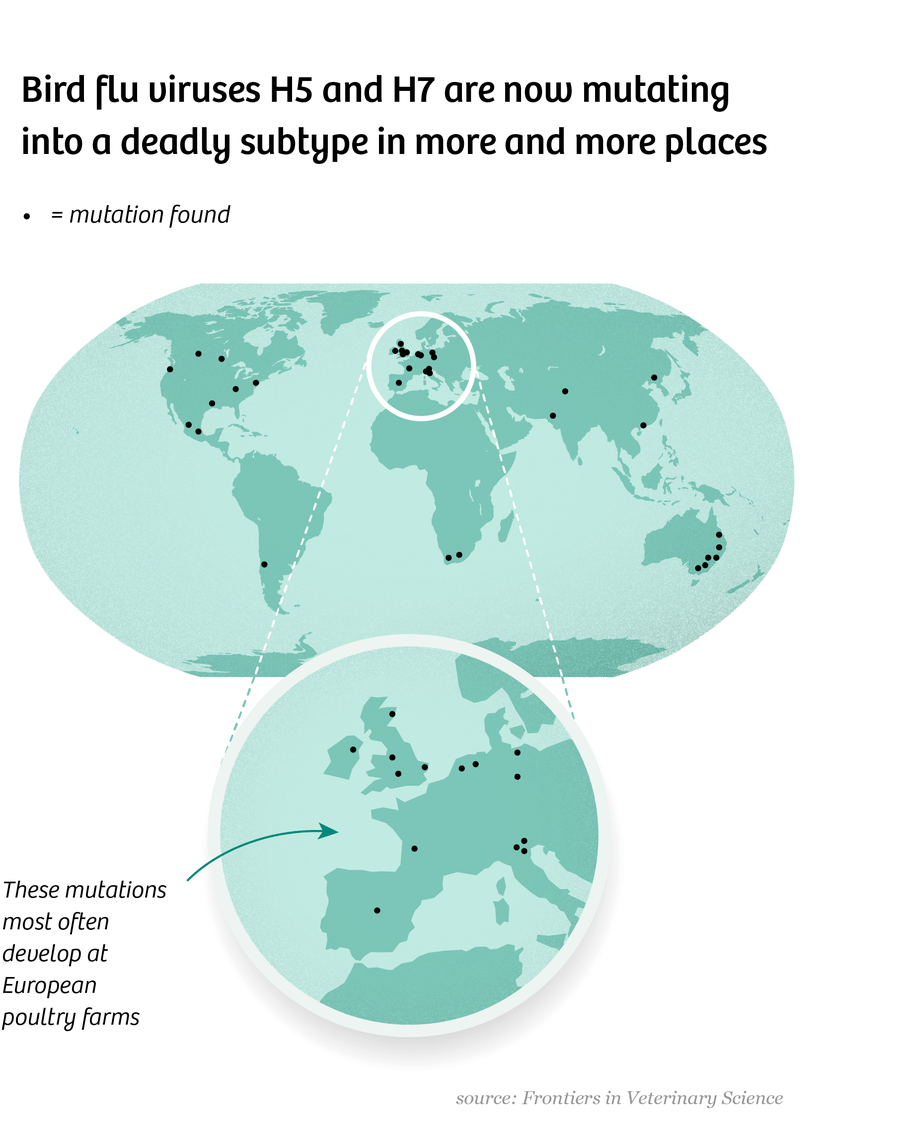
Until the fifties, chickens were almost exclusively kept by farmers who also had other livestock and raised crops. In 1952, there were already 24 million chickens in the Netherlands, but they were spread out over 300,000 farms, with a legal maximum of 350 chickens.
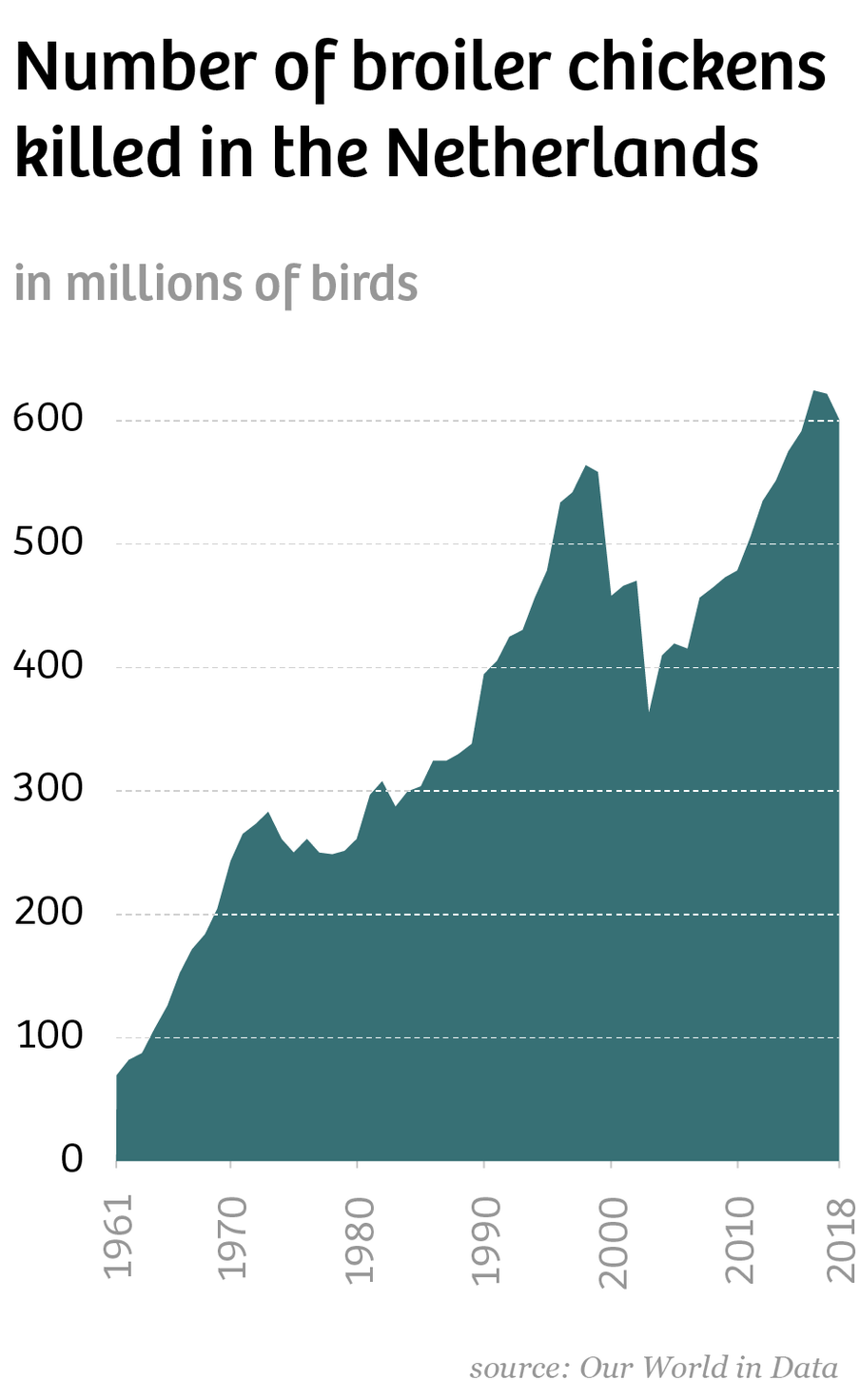
But in the fifties, the government changed its strategy in order to remain competitive with other countries. The number of chickens in the Netherlands grew quickly, while the number of farms decreased. Not only that, but the many strong traditional chicken breeds were replaced by hybrid breeds that lay more eggs or yield more meat, but are more susceptible to illness.
Now there are about 2,000 poultry farms left, concentrated in three areas. Together, they house more than 100 million chickens. Because broiler chickens in particular do not live long, this means that an enormous number of chickens are slaughtered every year (and that’s excluding the 40 million male chicks that are “shredded” every year).
The risk of a pandemic is growing
The fact that the last large-scale bird flu pandemic, killing tens of millions of people, took place 100 years ago doesn’t say much, then. Because never before in history have people kept so many chickens so close together.
This means it wasn’t a huge surprise when a deadly bird flu virus mutated in the Netherlands in 2003, infecting more than 1,000 people, according to estimates, one of whom died of the disease (a vet). The virus spread like wildfire through the chicken farms in the Gelderse Vallei, and also appeared in the south of the Netherlands and in other countries. In order to prevent its further spread, 30 million chickens were culled – gassed and burned.
Luckily the virus didn’t turn out to be very contagious when passed from human to human, but that could easily be the case for a new subtype. Practically every scientific study on the matter notes that a bird flu epidemic like the Spanish flu – or worse – could happen again.
The solution: greater biosecurity?
The poultry industry’s solution is the same as it has been for decades: increasing so-called biosecurity – protecting chicken farms from the outside world as best as possible. But that only works to a certain extent, as the many small outbreaks show. It’s impossible to seal off farms hermetically. Tons of food have to be brought in on a daily basis, and tons of droppings are brought out. Huge ventilators suck the outside air in, and circulate the air from inside back out again to make sure that so many bodies so close together don’t become overheated and stay as dry as possible.
Bacteria are invisibly small. But viruses are much smaller even than that. A flu virus compared to a salmonella bacteria, for instance: that’s a rabbit compared to a whale.
As soon as a contagious bird flu strain breaks out in one enormous factory farm, so indescribably many minuscule virus particles are produced that it is impossible to prevent them from spreading outside. Thanks to rodents, birds, flies, dust particles, farmers’ clothes, destruction teams and so on, it’s simply not possible to stop the further spread of a contagious virus outbreak between farms. This also applies to the Netherlands, as the mass infection rate in 2003 shows.
Measures to seal off a farm securely are extremely expensive. But the bigger the farm, the lower the costs per chicken – exactly the reason why the number of enormous factory farms is growing in the Netherlands. And this in turn increases the (economic) value of greater biosecurity. It’s a vicious circle.
Meanwhile, deadly H5 avian flu viruses have become endemic in chickens. This means that the virus is circulating constantly and can no longer be eradicated (just like less harmful flu viruses in humans). First in Asia, and by now also Africa, the Middle East and eastern Europe.
So no matter how hard we try to stay free of bird flu in western Europe, a new outbreak is always on the horizon.
What should we do now?
How does our avian flu expert Thijs Kuiken actually see the future? I asked him at the end of my private avian flu seminar.
What we can do in the Netherlands is actually fairly obvious, he explains. “The risk of an outbreak is high because of the way we keep poultry.”
Dutch chicken farms, like those in the rest of the world, are growing bigger and bigger. According to the most recent figures, there are now about 120 farms with more than 120,000 battery chickens in the Netherlands, and 34 farms with more than 220,000 broiler chickens. They are situated close together, also often in areas where there are many waterfowl. “It would help to have smaller farms and spread these across the country, in places where there are as few waterfowl as possible,” says Kuiken.
“What would also help enormously is vaccinating chickens against known bird flu strains.” There are simple, highly effective vaccines available.
That sounds obvious. So why aren’t we doing it? “The European measures against deadly bird flu aim to benefit the export of poultry products as much as possible,” says Kuiken. And funnily enough, that’s not the same as trying to prevent chickens from falling ill.
The countries where our chicken goes, especially Germany and Great Britain, are also trying to stay virus-free. That’s why chicken can only be exported when it’s free of bird flu – which is why exports are on hold at the moment.
“And so it’s crucial to track down and extinguish an outbreak as soon as possible. Vaccination actually makes that harder,” Kuiken explains. Vaccination ensures that chickens don’t get ill from bird flu and barely spread it. But that does mean that it’s easier for the virus to be present silently, without signs or symptoms.
So Europe is consciously choosing to accept a higher risk of a deadly outbreak, and to cull large numbers of chickens regularly. This is purely because of the economic importance of exports.
In the Netherlands, it’s clear what measures we need to take if we want to prevent outbreaks as much as possible: keep fewer chickens, give them more space and vaccinate them. On a global scale, this is a bit harder.
The number of chickens worldwide has been growing faster and faster over the last decades. Eighty billion chickens are now produced per year.

In parts of Asia, chickens are also kept in enormous, closed-off factory farms, but unlike in Europe, those are often right next door to small farmers where chickens or ducks roam free. It doesn’t get more dangerous than that. Purely from an epidemiological perspective, with so many chickens, it might be better only to work with large, closed-off chicken farms located far away from one another. That way you minimise the contact between poultry and wild waterfowl.
“But still, that’s not the solution I would advocate,” says Kuiken. “Large poultry farms are bad for their environments – in terms of their nitrogen emissions, for instance, but there is also a higher incidence of lung disease in the Dutch regions where there are large poultry farms.”
What’s more, it’s impossible to provide chickens at these enormous farms with locally sourced food. You have to bring that in from outside, which almost always leads to a loss of biodiversity elsewhere.
“Ultimately,” says Kuiken, “the only solution is to keep much less livestock, decrease the size of farms, and trade regionally.” That’s beneficial for our health and for nature in general. “With small farms we can very effectively create a robust system. In that situation, if there happened to be a bird flu outbreak, it wouldn’t be such a big problem. The system would be much more flexible.”
There would be very little risk of a deadly virus, and without strict export rules you could simply allow sick animals to recuperate.
Thijs Kuiken is working from the basic principle that the health of humans, animals and environment are mutually interdependent. “Deadly bird flu is terrible for chickens themselves. We’re also creating a huge problem for wild animals, who are under pressure anyway because of their shrinking habitat. And of course it’s a dangerous risk for humans. In the last hundred years, it has been proven many times that intensive cultivation of livestock leads to deadly pandemics.”
“If we want to continue existing on this earth as humans, we will have to start taking other species into account in a big way. And we have to be willing to do more for this. Or actually, less.”
Translated from the Dutch by Hannah Kousbroek.
Dig deeper
 Dear David Attenborough, beautiful Netflix documentary. But your ‘solutions’ destroy nature even more
David Attenborough’s Netflix documentary champions Dutch agriculture, but the truth is more complicated.
Dear David Attenborough, beautiful Netflix documentary. But your ‘solutions’ destroy nature even more
David Attenborough’s Netflix documentary champions Dutch agriculture, but the truth is more complicated.


